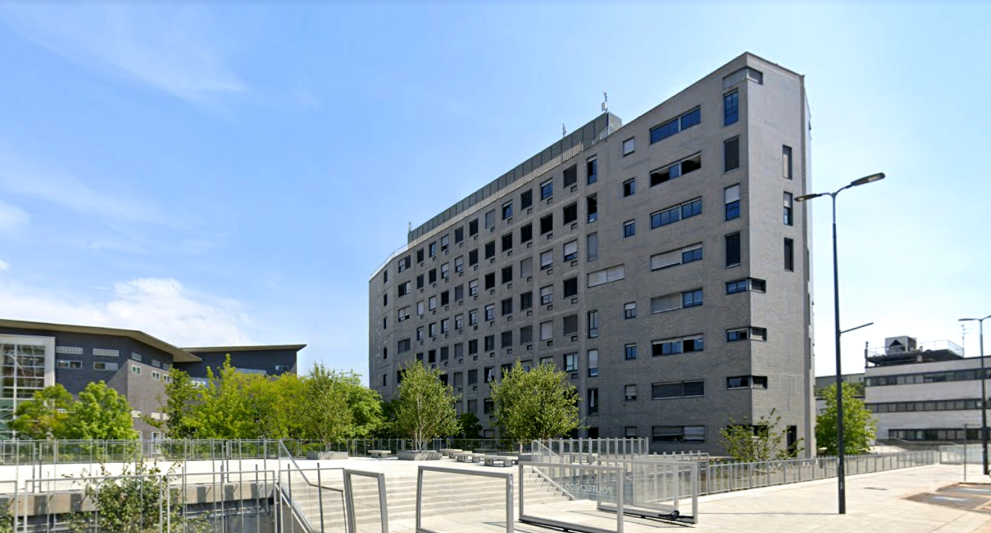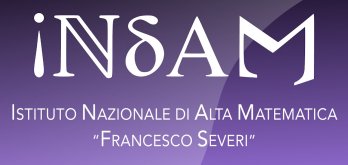Venue

Department of Mathematics,
Sala Consiglio,
7th floor,
Via E. Bonardi 9, 20133 Milano, Italy
Getting there:
Cahn–Hilliard models for tumor growth
Modelling of tumour growth is one of the challenging frontiers of applied mathematics. In the last years, phase field models for tumour growth have been studied intensively. Alike classical free boundary models they use a continuum approach to describe the growth of tumours. However, an advantage to free boundary models is that phase field models allow for topology changes like break up and coalescence. In addition, phase field methods can be used numerically without an explicit tracking of the interface which is necessary for free boundary models. In my talk I will introduce several macroscopic models for tumour growth in which cell-cell adhesion effects are taken into account with the help of a Ginzburg–Landau type energy. The resulting evolution equation is a Cahn-Hilliard equation taking source and sink terms into account. In addition, nutrient diffusion is incorporated by a coupling to a reaction-equation diffusion. I will show existence, uniqueness and regularity results. I will also discuss how to couple the system to an internal velocity field which either solves a Darcy-type or a (Navier-)Stokes system or a viscoelastic system. Properties of solutions will be illustrated with the help of numerical simulations.
The stochastic Cahn-Hilliard-Cook model with logarithmic potential and conservative noise
We present some recent results on the stochastic Cahn-Hilliard-Cook equation with logarithmic potential and conservative Wiener noise. First, existence of solutions is shown by using a suitable compensation between the singularity of the potential and the degeneracy of the multiplicative-type noise. Secondly, some selected open problems are discussed, in the direction of ergodicity and random separation property. The works presented in the talk are based on joint collaborations with Andrea Di Primio, Maurizio Grasselli, and Margherita Zanella.
Using mathematical modelling to understand how the microenvironment influence cell behaviours in cancer and atherosclerosis
Cells experience multiple stimuli which may alter their behaviour or phenotype. For example, following injury, endothelial cells proliferate and bias their movement up spatial gradients of diffusible species in order to generate new blood vessels for wound healing. In this talk, we will present two case studies which show how mathematical approaches can be used to describe cell responses to different environmental cues. First, we develop a two-phase model for cell migration in response to interstitial flow. We formulate the model as a system of continuum equations for the spatio-temporal evolution of the cell volume fraction and flux, in response to mechanochemical stimuli. As has been observed experimentally, the model predicts downstream-oriented, chemotactic migration at low cell volume fractions, and upstream-oriented, tensotactic migration at larger volume fractions. We show that the critical volume fraction, at which the system transitions from downstream to upstream migration, is dominated by the ratio of the rate of chemokine secretion and advection speed. Our model also predicts that upstream, tensotaxis-dominated migration only occurs at early times, and that downstream, chemotaxis-dominated migration persists at later times due to the dispersive effect of cell diffusion. We will then introduce a lipid structured mathematical model to investigate the impact of low- and high-density lipoproteins on the distribution of lipid across macrophages within atherosclerotic lesions. Macrophages are the dominant immune cell type within such lesions and their ability to ingest and off-load lipid is strongly dependent on their lipid load. Using a combination of numerical and analytical methods, we show how the balance between low- and high-density lipids determines whether the macrophage distribution is skewed towards low levels (healthy state), high levels (pathological state) or unimodal (a transitional state).
Local asymptotics and optimal control for a viscous Cahn-Hilliard-Reaction-Diffusion model for tumor growth
We study nonlocal-to-local asymptotics for a tumor-growth model coupling a viscous Cahn-Hilliard equation describing the tumor proportion with a reaction-diffusion equation for the nutrient phase parameter. First, we prove that solutions to the nonlocal Cahn-Hilliard system converge, as the nonlocality parameter tends to zero, to solutions to its local counterpart. Second, we provide first-order optimality conditions for an optimal control problem on the local model, accounting also for chemotaxis, and both for regular or singular potentials, without any additional regularity assumptions on the solution operator. The proof is based on an approximation of the local control problem by means of suitable nonlocal ones, and on proving nonlocal-to-local convergence both for the corresponding dual systems and for the associated first-order optimality conditions. This is joint work with Elisabetta Rocca, Luca Scarpa, and Lara Trussardi.
Aronson-Bénilan estimate and applications of tumor growth
In a celebrated three-pages long paper in 1979, Aronson and Bénilan obtained a remarkable estimate on second order derivatives for the solution of the porous media equation. Since its publication, the theory of porous medium flow has expanded relentlessly with applications including modeling of tissue growth and cancer development. In this talk, based on [1], we first motivate the use of the porous media equation to study the phenomenon of the tumor growth and then we present an extension of the Aronson-Bénilan estimate in L^∞ holding for any fields of pressure.
[1] G. Bevilacqua, B. Perthame, M. Schmidtchen; The Aronson-Bénilan estimate in Lebesgue spaces, Ann. Inst. H. Poincaré Anal. Non Lineaire (2023), 40(2), pp. 259-286.
Phase-field modeling of prostate cancer growth and treatment response
Advanced prostate cancer is usually treated with systemic drug-based therapies. The choice of the therapeutic agents and their regimen is based on clinical guidelines, which recommend fixed treatment plans that have shown adequate efficacy and safety in clinical studies over large patient cohorts. Additionally, the rationale for switching treatments relies on the observation of tumor progression under the originally prescribed therapeutic regimen. However, this population-based, observational approach largely ignores the heterogeneous nature of prostate cancer within and between patients, which underlies the specific dynamics of growth and response to treatment exhibited by different individuals, and it does not enable the early identification of patients who will require switching therapies or which treatment regimen will be optimal for each patient. In this talk, I will propose to address these issues by leveraging biomechanistic models of prostate cancer growth and therapeutic response. These models can be used to predict tumor progression under alternative treatment regimens as well as to systematically determine the best clinically-feasible tumor regimen for each patient by using optimal control theory. Towards this end, I will present a biomechanistic model describing the dynamics of prostate cancer growth, the production of a key biomarker (PSA), and the response to therapies. As prostate cancer growth can be interpreted as an evolving interface problem between healthy and tumoral tissue, the model is based on an Allen-Cahn phase-field equation to account for the coupled dynamics of both tissues. Isogeometric analysis (a recent generalization of the finite-element method) will be utilized to accurately and efficiently address the nonlinearity of the model and the intricate tumoral morphologies. I will also present an optimal control framework that aims at finding the therapy that minimizes the tumor burden and PSA within an admissible range of maximal drug concentration to limit toxicity. To facilitate the design of clinically- feasible optimal drug regimens, the optimal control framework relies on two steps. First, optimal control theory is used to calculate a theoretical, drug-naïve pharmacokinetic profile yielding optimal drug effects. Then, several available drugs and their known pharmacokinetic profiles can be used to design feasible treatment regimens matching the theoretical result. Finally, I will present ongoing work aiming at estimating the initial conditions of the biomechanistic model given spatial data on the tumor at a certain time. This capability has interest in both preclinical and clinical settings to improve our understanding of prostate cancer dynamics and facilitate model calibration to patient-specific data.
Minimal time control problem for Allen-Cahn equation
The minimum time optimal control problem means to search for a constrained internal control, active only from a starting time point to an ending time point, driving the solution of the controlled system from an initial state set (at the starting time) to a target set (at the ending time) such that the length of the interval where the control is active is the shortest among all such candidates. We prove the minimal time optimal control for a family of equations of Allen-Cahn type and provide the characterization of the control and the minimum time by the optimality conditions determined under a set of hypotheses expressing certain properties of the operator acting in the equation.
Analysis of a multi-species Cahn-Hilliard-Keller-Segel tumor growth model with chemotaxis and angiogenesis
In this talk I will present a Cahn-Hilliard-Keller-Segel multiphase field model for tumor growth with chemotaxis and angiogenesis, derived from a diffuse-interface mixture model to describe the growth dynamics of the different components of glioblastoma multiforme (GBM) identifiable by neuroimaging data. I will describe the main steps to obtain existence and regularity results of weak solutions of a reduced version of the full system in two and three space dimensions. I will finally show numerical simulations of the full model for a clinical test case, and conclude with some remarks on the predictive power of the proposed model and on future developments. This is a joint work with Andrea Signori (Politecnico di Milano) and Sabino Luzzi (Neurosurgery Unit, University of Pavia).
Derivation and simulation of a two-phase fluid deformable surface model
To explore the impact of surface viscosity on coexisting fluid domains in biomembranes we consider two-phase fluid deformable surfaces as model systems for biomembranes. Such surfaces are modeled by incompressible surface Navier-Stokes-Cahn-Hilliard-like equations with bending forces. We derive this model using the Lagrange-D'Alembert principle considering various dissipation mechanisms. The highly nonlinear model is solved numerically to explore the tight interplay between surface evolution, surface phase composition, surface curvature and surface hydrodynamics. It is demonstrated that hydrodynamics can enhance bulging and furrow formation, which both can further develop to pinch-offs. The numerical approach builds on a Taylor-Hood element for the surface Navier-Stokes part, a semi-implicit approach for the Cahn-Hilliard part, higher order surface parametrizations, appropriate approximations of the geometric quantities, and mesh redistribution. We demonstrate convergence properties that are known to be optimal for simplified sub-problems.
On a non-isothermal Allen-Cahn model for tumor growth
We present a new diffuse interface model describing the growth of a tumor, whose evolution is assumed to be governed by biological mechanisms such as proliferation of cells via nutrient consumption and apoptosis. In this context, the tumor is seen as an expanding mass surrounded by healthy tissues, while the interface in between contains a mixture of both healthy and tumor cells. More precisely, we model the process through a non-isothermal Allen-Cahn system coupled with a reaction-diffusion equation for the nutrient, following the approach based on microforce balance and then study its well-posedness. Namely, we are able to prove the existence and uniqueness of a solution to our model by Galerkin's approach. This is a joint project with Stefania Gatti and Alain Miranville.
On a Navier-Stokes-Cahn-Hilliard system with chemotaxis, active transport and nonlocal interaction
We consider a Navier-Stokes-Cahn-Hilliard model for viscous incompressible two phase
flows where the mechanisms of chemotaxis, active transport and nonlocal interaction of Oono's type are taken into account. The evolution system couples the Navier-Stokes equations for the volume-averaged fluid velocity, a convective Cahn-Hilliard equation for the phase field variable, and an advection-diffusion equation for the density of chemical substance. This system is thermodynamically consistent and generalizes the well-known “Model H” for viscous incompressible binary fluids. For the initial-boundary value problem with a physically relevant singular potential in three dimensions, we discuss its well-posedness and long-time behavior of global solutions.

Cecilia Cavaterra
cecilia.cavaterra@unimi.it
Matteo Fornoni
matteo.fornoni01@universitadipavia.it
Andrea Giorgini
andrea.giorgini@polimi.it
Elisabetta Rocca
elisabetta.rocca@unipv.it
Andrea Signori
andrea.signori@polimi.it



